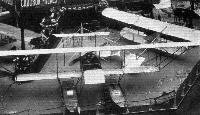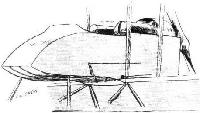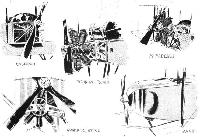L.Opdyke French Aeroplanes Before the Great War (Schiffer)
Deleted by request of (c)Schiffer Publishing
Type K: This was the big 2-seat pusher seaplane at Deauville in August 1913, powered by a 200 hp Anzani.
Type L: This was a side-by-side 2-seater seaplane pusher.
Журнал Flight
Flight, December 13, 1913.
THE STANDS AT THE PARIS AERO SHOW.
CAUDRON.
On the stand adjoining that of the Deperdussin, Caudron Brothers are showing two machines, one for work overland and the other a hydro-aeroplane. The land machine differs in constructional details only from those already known to our readers through illustrated descriptions in the columns of FLIGHT. The hydro-aeroplane is of the "pusher" type, and has a nacelle of somewhat different shape from those usually fitted. The floats are similar to those fitted on the tractor type of machine, the chassis possessing wheels as well as floats, so that the machine is really amphibious.
Flight, December 20, 1913.
THE PARIS AERO SALON - 1913.
CAUDRON
Of the two machines exhibited on the Caudron stand, the hydrobiplane, is, perhaps, the more interesting, as it is less known to our readers than the land machines, of which so many are to be seen daily at the London Aerodrome. The hydro-biplane is of the "pusher" type, having the engine - a 100 h.p, 9-cylinder Gnome - mounted between double bearings in the rear end of the nacelle. It drives through a 2 to 1 reduction gearing the propeller, which has been mounted on a long shaft in order to clear the trailing edges of the main planes.
In the front portion of the nacelle are the pilot's and passenger's seats, arranged side by side, the pilot occupying the right-hand seat. In front of him are the controls, which consist of a single wooden lever which works the warp and elevator, whilst the rudder is actuated by a foot-bar. The outrigger, which carries the tail planes, consists of four steel tubes connected by spruce struts. The tail planes comprise a slightly cambered fixed tail plane, to which is hinged the divided elevator. The rudder is hinged to the vertical rudder-post which joins the rear extremities of the tail booms. A tail fin is provided in order to balance the side area of the floats. A small tail float is mounted on an extension of the vertical rudder-post, and protects the tail planes against contact with the water.
The main floats, of which there are two, are of the already well-known Caudron type, built by Mons. Tellier. The floats are pivoted round the lower extremities of the front chassis-struts, and are sprung from four short skids by means of rubber shock-absorbers at the rear. Mounted in an opening in the centre of the float is a wheel which projects slightly below the step of the float, so that the machine is really amphibious. The wheels are not sprung from the floats, but depend for their springing on the shock-absorbers, by means of which the rear part of the float is attached to the skids.
The main planes are of the usual Caudron type, having the two main spars fairly close together, and possessing the flexible trailing edge which characterises the land machines. The upper main plane has a considerable overhang, that is to say it has a much greater span than the lower plane. The main planes are connected by six pairs of vertical struts of hollow spruce, with the exception of the inner ones, which are made of ash. The thrust is transmitted from the nacelle to the wings by bolting the nacelle to the main spars of the lower plane and to the inner plane struts.
<...>






